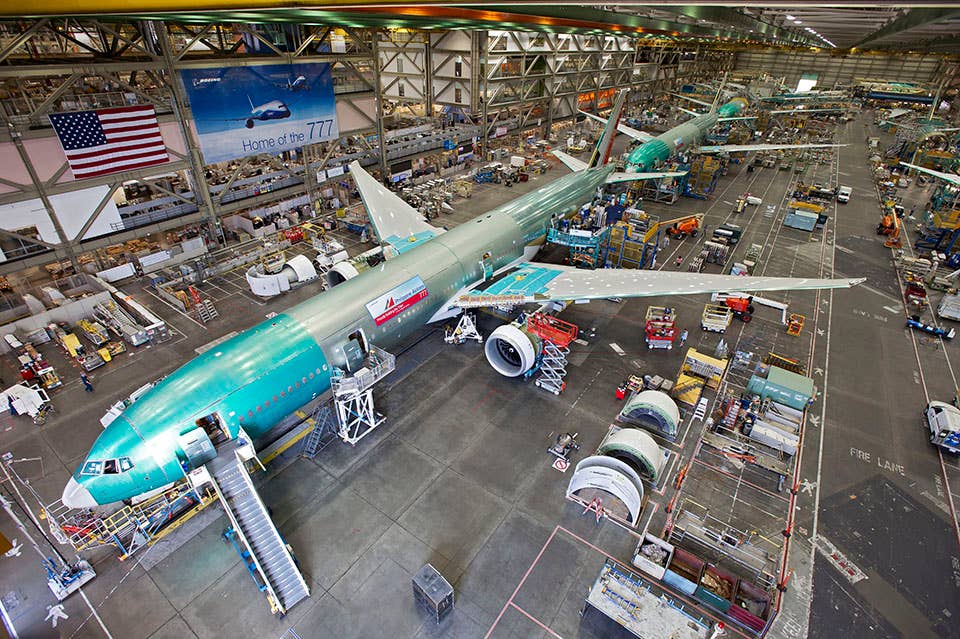Boeing Plans Dynamic Digital Ecosystem
Boeing plans to shift its massive commercial aviation design and production systems to a unified, digital ecosystem in an effort to increase revenue and reduce potential problems.

Boeing wants to use digital technology to cut costs, reduce problems, and accelerate production. [Courtesy: Boeing]
Boeing (NYSE:BA) is planning to build a powerful digital ecosystem for its commercial aviation company aimed at increasing revenue and reducing potential problems with design and production.
Imagine linking Boeing engineers around the world with 3D, virtual reality headsets so they could collaborate in real time, leveraging vast amounts of interlinked data across all internal databases. The result would be a digital ecosystem that could save money, boost sales, avert mistakes, and accelerate production timelines for clean-sheet airplane designs.
Moving Forward
It’s been two years since Airbus (EURONEXT FR:AIR.FP) snatched Boeing’s crown as the world’s top aviation OEM by revenue and deliveries. Now, Boeing is looking beyond the 737 Max debacle and recent challenges with its sophisticated 787 Dreamliner.
First reported by Reuters—and confirmed to FLYING by Boeing—chief engineer Greg Hyslop offered details about the company’s emerging plans.
"It’s about strengthening engineering,” Hyslop told Reuters. “We are talking about changing the way we work across the entire company.”
Hyslop told Reuters the overwhelming number of production quality issues stem from design problems. An overall digital ecosystem would improve both design and production. If successful, the timeline from concept to market could shrink to as short as four to five years, Reuters reported.
The Airbus Digital Ecosystem
Boeing rival, Airbus, has been ramping up its digital ecosystem program, dubbed Digital Design and Manufacturing Services for the past five years. DDMS aims to fully transform Airbus’ design, manufacturing, and overall operations to a digital-first model from end to end. The goal: cut costs and reduce time to market while ensuring quality, safety, and environmental performance.
A 2019 report to the company’s board of directors said Airbus intends to build “a new worldwide industrial ecosystem” to “design, produce and maintain aircraft.” Ultimately, “DDMS’ ambition is no less than to achieve a native digital continuity for 3D design, engineering, manufacturing, services, simulation, and artificial intelligence activities, with the mandate to be ready for the next aircraft program.”
As both Airbus and Boeing are now increasing their digital aircraft design and production capabilities, neither has announced plans for a new clean-sheet commercial airliner program.
“It makes no sense at all unless you’re creating a new airplane, which they both badly need to create and don’t show any signs of creating,” said Richard Aboulafia, veteran commercial and military aviation consultant and vice president of analysis at Teal Group.
Last year, Airbus said it was already using DDMS to create virtual factory simulations for the emerging A321XLR—a long-range variant of Airbus’ popular, single-aisle A321. DDMS is being used to develop design and assembly simulation—as well as simultaneous real-time 3D visibility—at Airbus facilities in Toulouse, France; Hamburg, Germany; and Filton, England.
Next-Level Computer Design and Manufacturing
The commercial aviation industry has been creating airplanes using computer-aided design in evolving formats for decades. In the 1990s, Boeing’s 777 was touted as the first transport category jet that was 100 percent digitally designed using 3D graphics programs, which allowed it to be pre-assembled by computer, skipping the necessity of an expensive, full-scale mock-up.
More recently, the company has worked to move its manufacturing systems forward in order to share and communicate data across management for production life-cycle and manufacturing operations and resource planning. The Boeing Sheffield fabrication facility in the U.K. includes fully digital-capable infrastructure and state-of-the-art machinery and is intended to serve as an incubator model to replace legacy systems.
Developing a full digital ecosystem could take Boeing’s design and manufacturing to the next level. The result would be a system-wide, immersive, virtual world that would increase the power of Boeing’s engineering data and supercharge its resources.
Boeing’s defense arm used digital simulation to quickly build the first T-7A Red Hawk jet trainers for the U.S. Air Force. That program has had its share of minor issues, so far. “I guess T-7 will be a really interesting test case about whether this is an oversold panacea,” Aboulafia told FLYING.
In a typical digital ecosystem, aeronautical engineers and industrial engineers would create digital twins of their aircraft along with specifically designed virtual production systems. Digital twins are virtual copies of real objects that can be performance tested using computer simulations. With a digital ecosystem, complex tests and experiments that would be time-consuming and expensive to execute in the real world could be streamlined in the virtual world.
This kind of technology would empower engineers to more effectively pinpoint potential flaws and figure out ways to overcome challenges long before the problems show up in reality.
Boeing is predicting $9 trillion in aerospace market opportunities during the next decade. Leveraging the power of digital technology will be critical for the company so that it can take advantage of the market and keep pace with its competitors.

Sign-up for newsletters & special offers!
Get the latest FLYING stories & special offers delivered directly to your inbox






